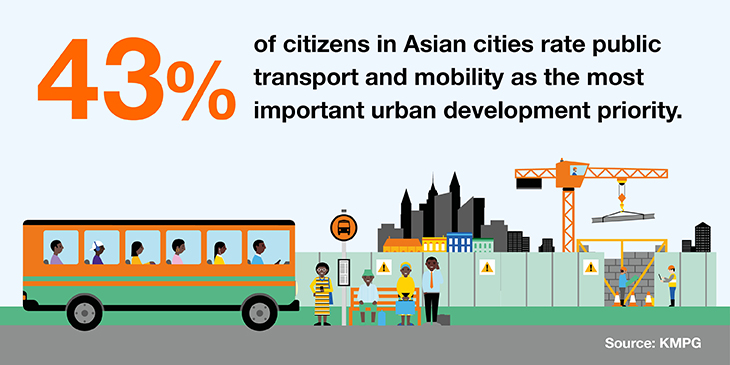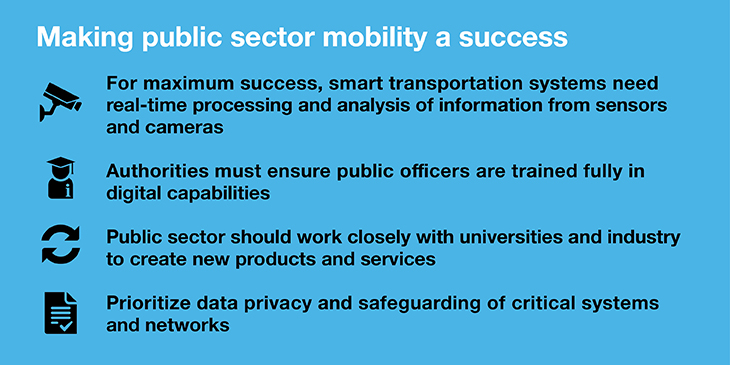This rapid population growth in cities is driving the need for improved public transportation: in a KPMG survey, 43% of citizens in APAC cities rated public transport and mobility as the most important urban development priority. Smart mobility projects – initiatives that use digital technology to transform traditional transport systems – throughout APAC are helping overhaul public transport and improving the lives of citizens and visitors.

India: better junctions
The priority for public sector mobility schemes in India is twofold. Traffic congestion is a major long-term cause for concern, and today more Indian citizens have entered the middle class and have more disposable income, which has meant more people buying cars, which means more congestion. On average, citizens in Delhi, Mumbai, Bengaluru and Kolkata spend 1.5 hours more on their daily commutes than their counterparts in other Asian cities, while traffic congestion is estimated to cost India’s economy more than $22 billion per year.
Safety is the other big factor. In India, more than a million people have died in road accidents in the past decade, and in addition to this tragic human tale, there is also a basic economic imperative: India’s ministry of road transport and highways reports that commercial losses from road accidents equates to 3% of GDP, around $8.2 billion every year.
“It’s a big deal and something India has to address,” says Bala Mahadevan, Country General Manager for Orange Business India. “More than half of India’s road deaths happen at traffic junctions, and digital technologies in smart public sector mobility projects can have a big impact on reducing this terrible loss of life. Effective, efficient public transport in India can lower congestion by reducing the number of car journeys taken and also help lower the number of accidents.”
With safety at front of mind, India has set out to improve the safety of junctions with tools like smart junction management and intelligent public transport systems. Video monitoring and analytics are also in play, tasked with detecting traffic anomalies and sending alerts about offenses or incidents in real time to prevent accidents. “Orange is proud of our work with the government of Gujarat on digitally-powered safety initiatives on the Safe and Secure Gujarat project,” continues Mahadevan. “It’s part of a massive smart city scheme and will deliver next-generation traffic management to Gujarat’s 120 cities over time.”
The Gujarat project, one of the largest smart city schemes in India, involves implementing intelligent traffic management systems to help reduce crime and traffic violations and improve overall traffic flow. Orange is developing a system of 35 command & control centers across the state. Using advanced analytics software and hardware solutions, Orange will develop a common platform that provides a unified view of public safety services, security response units, city police and medical dispatches.
Hong Kong: smarter payments
Hong Kong is a bustling metropolis where citizens take more than 12.6 million passenger trips on public transport every day. Hong Kong’s Mass Transit Railway (MTR) is relied on by both residents and tourists to get around, serving 5.6 million passenger journeys a day. Hong Kong is taking steps to improve the MTR’s service, making it even easier to use, and digital technologies are central to that.
The MTR has introduced Octopus, a smart payment system, and is extending that to offer mobile ticketing options using QR codes and ticket issuing machines that allow tourists to make smartphone payments for greater convenience. “Hong Kong has a vision, a plan to evolve our urban environment and services using digital technologies,” says Edmund Yick, General Manager for Orange Business Hong Kong.
“The Smart City Blueprint is all about transforming public mobility with initiatives like integrating public transport applications like HKeTransport, HKeRouting and eTraffic News all together into one universal app that makes mobility simpler for all users. By 2020, we’ll have real-time bus information available on smartphones and connected to 1,300 digital bus stops, mobile payments for parking meters, and more. And it’s all being backed up by an open data agenda that Hong Kong plans to use to enhance traffic flow, reduce congestion and improve road safety overall.”
Singapore: better, safer buses
Singapore is the world’s third most densely populated country with 8,274 people per square kilometer, which puts a strain on public transport infrastructure. As part of its Smart Mobility 2030 Strategic Plan, the government wants to reduce the number of cars in use and drive citizens and visitors to use public transport. To deliver this, big data is being leveraged to enhance the traveler’s experience, with smart traffic management to the fore. Vehicle connectivity is also a priority to enable new real-time services that improve urban mobility. Solutions like Orange Transport Video Alert are ideal, a tool that gives real-time visualization of video streams: if an incident takes place on a bus for example, drivers can press a button and trigger an alert, video is sent to a central command center to assess the live situation, and if necessary, alert law enforcement.
Australia: smarter transport innovations
Australia is making big transport advances, and late 2018 saw it establish the Office of Future Transport Technologies, a body that will pave the way for automated vehicle and other transport innovations. General transport and road safety improvements are the office’s core goals, which makes sense: road accidents in Australia are estimated to cost much as AU$27 billion each year.
Kevin Griffen, Country Manager for Orange Australasia, comments, “Over the next 30 years, Australia’s population will grow to about 36 million people, which is like adding a city the size of Canberra to the country every year. Three quarters of that growth will be in the biggest cities like Sydney, Melbourne, Brisbane and Perth, meaning massive added pressure on the city’s road networks.”
Orange and alliance partner GHD Digital are driving deployments of IoT to address Australia’s challenges across sectors such as public transport, construction and mining. The number of Australian companies using IoT solutions grew from 12% in 2013 to 29% in 2017, with transport the leading industry for IoT usage. The Australian future transport market was valued at AU$211 million in 2016, but the industry has been forecast to generate over AU$16 billion in revenue by 2025. Technology is very much helping transform Australia’s mobility sector.

APAC: better public transport for all
“Ultimately, the APAC region is ripe for the benefits that smart mobility can bring, and smart mobility schemes are already helping APAC countries achieve cheaper, faster, safer and more environmentally friendly mobility for citizens of all ages,” says Mark Tan, VP Global Solutions and Marketing, Orange Business APAC.
“All over the region, governments are investing in new mobility initiatives, leveraging IoT, AI, big data analytics and smart city thinking to transform urban mobility for citizens and visitors. They’re doing it the right way, with the right plans in place and working with the right partners like Orange to maximize their chances of success. Intelligent public transport management systems are helping make places throughout APAC better places to live and travel.”
To learn more about how public sector led smart mobility is transforming urban transportation throughout APAC, read the Orange and PwC report, Life in the Fast Lane.